Tragedy at Montjuich Park
A member of the Hill F1 team recalls the debacle of the deadly 1975 Spanish Grand Prix
Getty Images
Can it really have been 50 years ago? I remember the events of April 25-27, 1975 almost as if they happened yesterday. They are scarcely believable, especially when judged against the professionalism in Formula 1 in 2025.
My first recollection is making a hurried ascent of a steep street, a mile or so south of the Barcelona city centre, towards Montjuich Park. Alongside me was my friend and colleague, Nigel Roebuck. I didn’t know that I was walking into the worst weekend of my motor racing life – into an unremittingly scandalous and distressing experience.
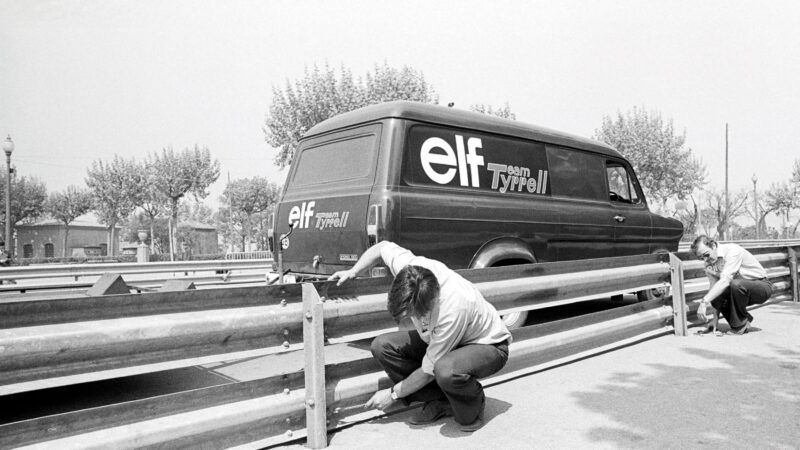
Monjuich Park, 1975 – the barrier installations were in a woeful state until the teams took it upon themselves to fix them. At work here are team owner Ken Tyrrell, left, and his designer, Derek Gardner.
Parts of the street circuit in the park, running up hill and down dale over 2.36 miles, were lined with baroque architecture that made it almost as picturesque as Monaco, but it was far more dangerous, with a lap average 25mph faster. It was staging the Spanish Grand Prix for a fourth time, and I was there as the press officer of the Embassy Racing With Graham Hill team. We were late for Friday practice. My fault… On the way, I had insisted on dipping into a department store to buy a belt of quality Spanish leather (I still wear it).
As we climbed the hill, we heard a Cosworth DFV firing up, and then its wails as the car was driven on the circuit, the noise bouncing off the buildings that surrounded us. After a few minutes, we were mystified by the sound of this car – because it was, and remained, the only one.
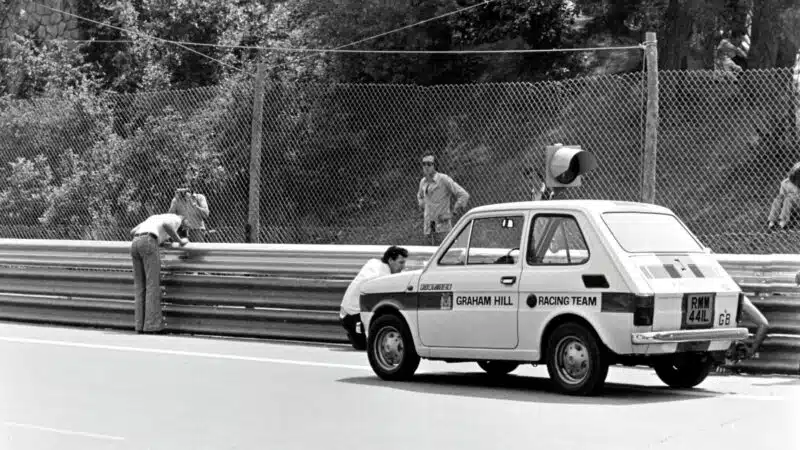
The Hill team busied itself on barriers around the start/finish line.
Getty Images
As we drew closer, we discussed possible scenarios. We worked out the probable identity of the driver before we saw him. Surely, it was Jacky Ickx.
Jacky – never a man to stand in the herd – had declined to join his fellow drivers in the Grand Prix Drivers’ Association. We reckoned that the GPDA might be in some kind of dispute with the race organisers, and that Jacky was doing his own thing.
And when the circuit came into our view, there, indeed, was Ickx in his black Lotus, plying his trade, but not plying it very hard. As we walked further up the hill, another car – Vittorio Brambilla’s March – appeared on the circuit.
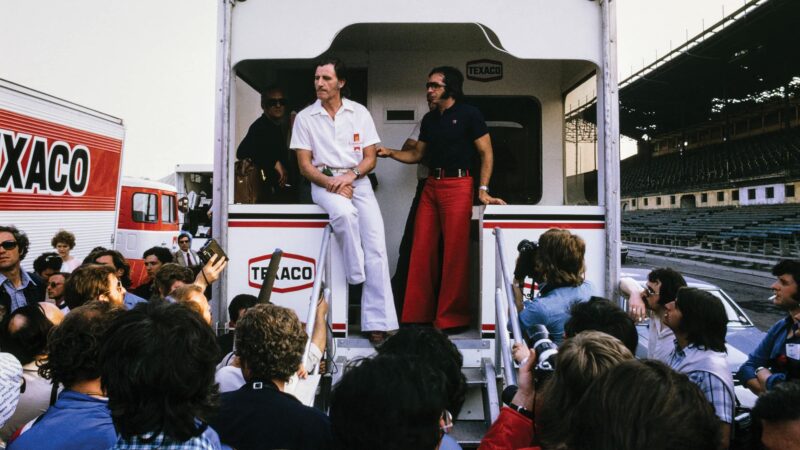
Graham Hill and Emerson Fittipaldi aired their fears to the gathered media – Fittipaldi chose to go home rather than risk his life
Getty Images
The pitlane was crowded with people huddled among silent racing cars. They were all talking about track safety. They had arrived to find that, pretty much all round the circuit, many of the Armco barriers had not been properly installed. Thousands of bolts were missing; hundreds were in little piles all round the trackside. Many of those that were in place had been secured finger-tight, without washers, to old lengths of rail in which the bolt-holes had been damaged. And many of the mounting posts were loose; some of the barrier could be moved back and forth with one hand.
The GPDA was empowered to undertake circuit inspections, and had done so. But the roadways in Montjuich Park were public and the GPDA representative, Jean-Pierre Beltoise, had been there before the guardrails had been erected. Beltoise had had to take the word of the organisers that proper barriers would be in place before race weekend.
“The drivers disappeared into a motorhome for a meeting”
The GPDA members had the awful knowledge that the recent deaths of three F1 drivers (Helmuth Koinigg, Peter Revson and François Cevert) had been caused by impacts with inadequate guardrails. They absolutely had to make a stand.
Ickx and Brambilla did only 11 timed laps between them and the circuit was silent long before the session finished. An hour later, the organisers promised the team owners and their drivers that work to secure the barriers would be undertaken through Friday night.
The drivers were sceptical. They sought out the delegates of the governing body, the CSI – but ‘the blazers’ had all left the circuit! The GPDA staged an ill-tempered press conference from the back of the Texaco motorhome in the paddock, stressing that it was the job of the CSI to ensure that the organisers reached the required standards.
On the Saturday morning, the drivers toured the circuit in little groups and found that their scepticism had been justified. Some work had been done but, whether through lack of time, insufficient materials or shoddy workmanship, the barriers were still dangerous. They disappeared into the motorhome for a lengthy meeting.

Lotus’s Jacky Ickx and McLaren’s Jochen Mass fought for the lead before the race was stopped on lap 29
Getty Images
The team owners and their managers, meanwhile, had a meeting of their own – and emerged with a plan of action. All the while, their mechanics had been lounging about, sunbathing, or playing football on the pitch in a big sports stadium behind the pits. Built for the city’s failed bid for the 1936 Olympics, the arena was being used over the weekend as the F1 paddock, with the motorhomes parked round the running track. Here was an idle workforce. Why not put them to work?
Each team was allocated a section of the circuit, and tasked with securing the barriers. Some of the team owners and managers also took up spanners. The mechanics, at least, kept a sense of humour. When the Embassy Racing ‘fitters’ finished their section, shortly after the start-finish line, one of them – Steve Roby, I think – used a black marker pen to write on top of it: “Don’t crash here please”.
Time, however, was against them. Their labours had a significant effect, and an inspection by CSI officials concluded that the guardrail was now adequate. But the scale of the problem made the task hopeless. There was no way it could be made safe enough to satisfy all the drivers in the time available before Saturday practice.
When the session began, only three cars – Ickx’s Lotus, the BRM of Bob Evans and the Ensign of his fellow rookie, Roelof Wunderink – took part. To the dismay of all the team owners (and the anger of some), the other drivers again locked themselves away in the motorhome, where an argument ensued. Some said the affair had gone far enough, that they had made their point. Others insisted that they should stick to their guns until the track had been made completely safe. Otherwise, what was the point of the GPDA?
A party from the organising committee appeared, armed with an ultimatum. The CSI delegates, they said, were satisfied that the circuit met the regulations. The Formula One Constructors’ Association had a contract with the Real Automóvil Club de Cataluña. This must be honoured. Otherwise the organisers would take legal action. For a start, they would impound the cars and equipment.
The stadium had only two vehicle entrances and both had high, steel gates. This was not an empty threat: it could be carried out in seconds. And, to make that point, a hundred or so Guardia Civil soldiers filed into the stadium. With rifles…
Now, finally, the team owners and their managers were allowed into the drivers’ motorhome, and some fast talking was done. The drivers were persuaded at least to do some laps, if only to meet FOCA’s legal commitments. Greeted by catcalls and whistles from a big crowd, which had been waiting very impatiently for some action, they all drove out of the pits.
After a few warm-up laps, to almost everyone’s astonishment most of them began to go quickly. The world champion, Emerson Fittipaldi, drove his Mcl.aren slowly round the track, one hand held high, for just three laps. Williams driver Arturo Merzario did more laps than Fittipaldi, but almost as slowly. Both men said later that they had expected all the others to do a few token laps and then to return to the pits so as to continue their protest. They were the only ones with the courage to act out their convictions. Clearly, the GPDA had now lost the confrontation.
On race morning, after the drivers – with the exception of Fittipaldi, who was on his way home to Switzerland – had confirmed that they would race, the tension was overpowering. There was the strongest sense of foreboding. It was a hot day, and the place was rammed with people. Everyone involved was on edge.
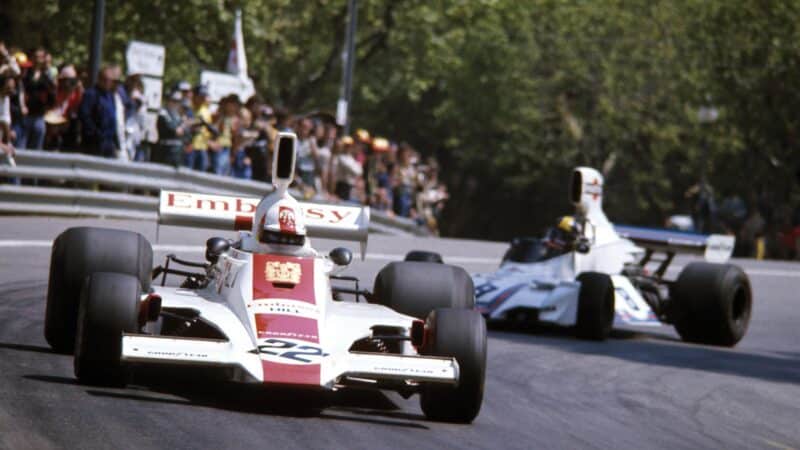
Stommelen put an Embassy-Hill car in front for the first time in an F1 race, chased by Brabham’s Carlos Pace.
Getty Images
We chose to watch the race from the first turn, a hairpin left, a hundred metres or so down the hill from the Rasante – an infamous ‘yump’ over which the cars momentarily had all four wheels off the ground at 150mph. A surge of sound echoed off the trackside buildings and then the pack of 25 multi-coloured lemmings burst into view over the yump, the two Ferraris at their head. As they braked for the corner, Brambilla made a move inside Mario Andretti and clipped him. The Parnelli was punted into Niki Lauda’s Ferrari, which struck the sister car of Clay Regazzoni. In an instant, both the red cars were broadside, and there was mayhem.
We were standing (with maybe 30 other people) in a 4ft space between the barrier and a high fence. The accident terrified me. I realised how stupid I had been to stand there. I stepped back and flattened my back and both arms against the fence, praying that none of these spinning projectiles was coming over (or even through) the barrier.
No car was lifted into the air, and the guardrail held, despite being hit by both Ferraris. In the confusion, several other cars were involved in collisions, among them Patrick Depailler’s Tyrrell, François Migault’s Hill, Evans’s BRM, Tom Pryce’s Shadow, and the Williams of brilliant young Tony Brise, who was making his F1 debut.
“There was the strongest sense of foreboding. It was hot. Everybody involved was on edge”
Merzario rolled past us, his engine silent, and parked his Williams in the escape road. Little Art always taped a pack of Marlboros and a lighter inside his cockpit, lest his car should strand him far from a source of nicotine. He had already lit up when he passed us on his way back to the pits. Nigel asked him what was wrong with the car. Nothing, he told us with a shrug, but this place was madness. Wilson Fittipaldi, adopting a similar stance, retired in the pits at the end of the first lap.
James Hunt led in the works Hesketh but soon Jody Scheckter’s engine blew in his Tyrrell, leaving a trail of oil. Mark Donohue’s Penske and Alan Jones’s Hesketh hit the oil and then the barriers and, when Hunt arrived, he went off trying to avoid the debris.
Andretti took over the lead. As we watched him come over the yump, we couldn’t help wondering if the Parnelli had been damaged in the first-corner incident. Indeed, it had. A top link of the rear suspension let go in a very fast, uphill sweeper leading to the pitstraight. John Watson, who had been hounding Andretti, flat-spotted his tyres and drove his Surtees to the pits.
And into the lead, for the first time in his career and the history of his team, emerged Rolf Stommelen in his brand-new Hill, challenged by Carlos Pace’s Brabham and Ronnie Peterson’s Lotus. Then Peterson crashed as the three lapped a backmarker.
Later, would I find myself writing a press release recording a victory for Embassy Racing? I had never thought it possible.
For nine laps, Stommelen kept Pace at bay, taking tight lines into the turns so that the Brabham could not pass. On each lap, when they were due, our eyes were fixed on the brow up the road as we waited to see if Pace had made it through. As they started their 26th lap, we glimpsed a flash of something white hurtling over the barrier near the yump, and heard screams.
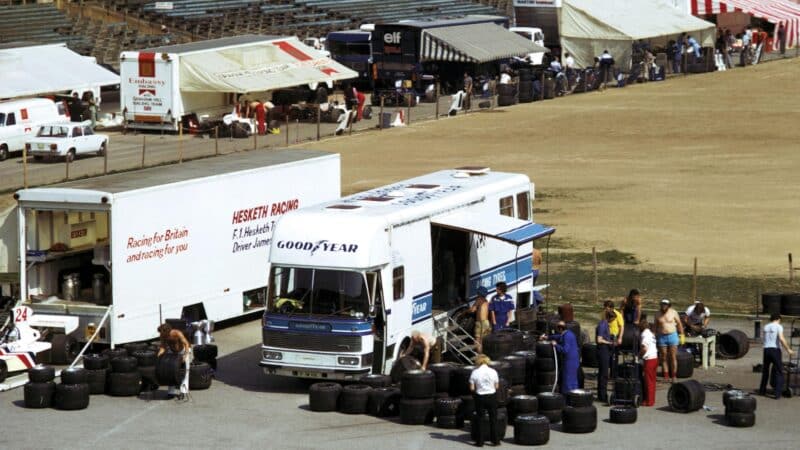
the paddock was a stadium built for Spain’s (failed) 1936 Olympic bid
Getty Images
It was Stommelen’s car. We found out afterwards that the rear wing had detached. The twin-strut support structure was made from a lightweight carbon material, then previously untried in racing (except by Hesketh). It had failed under the aerodynamic load, sending the wing spiralling into the air. The Hill had careened into the guardrail, then back across the track. It had landed on top of the barrier on the right – very near the spot where Rolf’s crew had left their message – and gone over it, felling a lamp-post.
All along the section, behind flimsy debris fencing, spectators were lined maybe five deep just a few feet from trackside. But Rolf went over into a restricted area containing a civic monument and a marshals’ post. This was incredibly fortunate: had the car vaulted the barrier a second earlier, or later, scores of spectators might have been killed.
“The team principals had been dismayed by the incompetence”
Down at the hairpin, we had no notion of the severity of the accident. Pace’s damaged Brabham came past us and he parked it, but the race continued, led by Jochen Mass.
Four more laps went by before the officials red-flagged the race. It was Lauda, in the pits, who convinced them to do so. Afterwards Mass was so angry that he had to be restrained from striking an official.
Once the track was open, we stepped over the guardrail to walk to the pits, past the scene of the accident. As we did so, there was a rush of liquid in the gutter. A marshal saw the liquid and turned towards a temporary grandstand behind us to shout a warning – “Benzina!” An image is seared into my memory of a middle-aged woman being the first to stand up, and instantly being knocked down in the rush to the exits. She and other people must have been trampled. Someone else put his finger in the liquid, then to his mouth. It was water…
The accident scene was appalling. The car was on its side several feet inside the restricted area, torn apart. This was the first real test of aircraft-specification, self-sealing fuel valves that had recently become mandatory in F1: the engine and gearbox had been ripped off the car, but there had been no fire. But four people – a fire marshal, two journalists, and a spectator who had been standing in the restricted area without a track pass – were dead. Graham Hill was there, helping to get Stommelen out of the wreckage and into an ambulance. Rolf was conscious, but both legs, several ribs and a wrist were broken.
The ambulance, which had taken 10 minutes to reach the scene after the race had been stopped, took Rolf (with Graham) to the Clínica Soler-Roig in Barcelona. Owned by the father of recent F1 driver Álex Soler-Roig, this was the same clinic that had treated Jochen Rindt’s injuries after his big crash here six years before – caused by the collapse of the high-mounted rear aerofoil of his Lotus 49 as it crested the Rasante yump. Rindt’s team-mate had already crashed at the same spot, and for the same reason – but Graham Hill had been unharmed.
The four bodies were removed, and nine injured onlookers (including an 11-year-old boy) also taken to hospitals.
I had some duties to perform in the press room but, later, I went to commiserate with the Embassy-Hill crew in the stadium. I found them suffering from shock: two had been sick on the grass behind the Revcon motorhome. I asked Ray Brimble, the team manager, if there was anything I could do. He asked me to return to the accident scene and look for any part of the wing mounting assembly. This had been a car failure, and he was fretting about the team’s position under Spanish law.
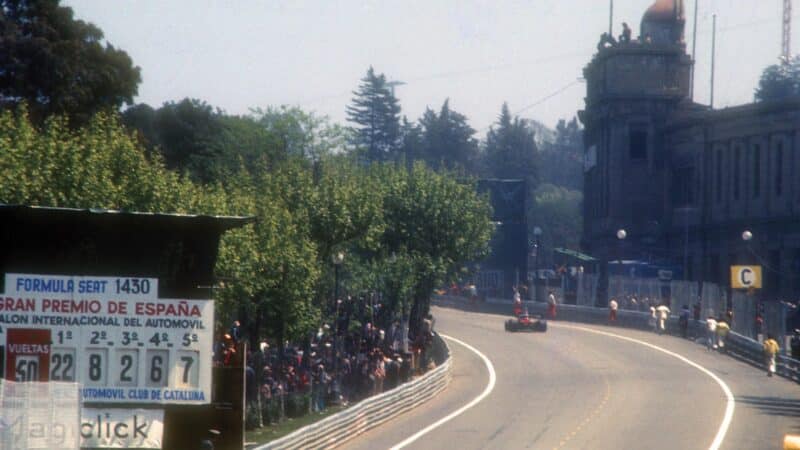
Mechanics run to the scene of the Stommelen crash; four people were killed
Grand Prix photo
I reluctantly agreed. I put on a set of the team’s overalls and drove back to the spot in its Fiat runabout. This little car was towed on an A-frame behind the Revcon to all the European races; its running gear must have done tens of thousands of miles, its powertrain a couple of hundred. A mass of debris and tangled wire fencing was roped off and guarded by a couple of desultory Guardia Civil sentries. It was then that an uncomfortable thought occurred… If I did find any carbon-fibre, could I be prosecuted for removing evidence from a crime scene?
But the sentries didn’t care. I looked all over for the grey parts the team had described, but I couldn’t see any. I was distracted by a crowd of people who had gathered there to gawp at the accident site. When they saw my overalls, they began venting their anger. Some of them abused me, shaking their fists and shouting. When one spat at me, I left.
The 1975 Spanish GP marked the end for Montjuich Park as an F1 venue. The team principals (including Brabham owner Bernie Ecclestone) had been dismayed by the incompetence of the race organisation there, and by their own inability to control the situations it caused. They would go on to grow their two-year-old FOCA into a group strong enough not only to take on the governing body in pursuit of their commercial interests, but also to collaborate with it in raising standards.
Twelve driver fatalities during the previous 10 seasons had already persuaded prominent figures in grand prix racing to press for new safety initiatives, these tending to focus on track barriers and the cars. The events in Barcelona served to underline that major improvements were essential across the board. Over time, disgraceful failings in race organisation of the type seen in Montjuich Park – in track inspection procedures, in medical arrangements and facilities, in spectator security (and accreditation scrutiny), in race control proficiency – would all be addressed as priorities alongside chassis integrity and cockpit protections.
For a long while now, all these matters have been controlled by a range of specialist FIA commissions and have been under the constant attention of professionals, forming working groups to resolve specific issues. Safety is now at the very core of everything that happens in F1. The shocking events in Montjuich Park graphically illustrate just how far it has come in the last 50 years.